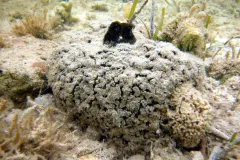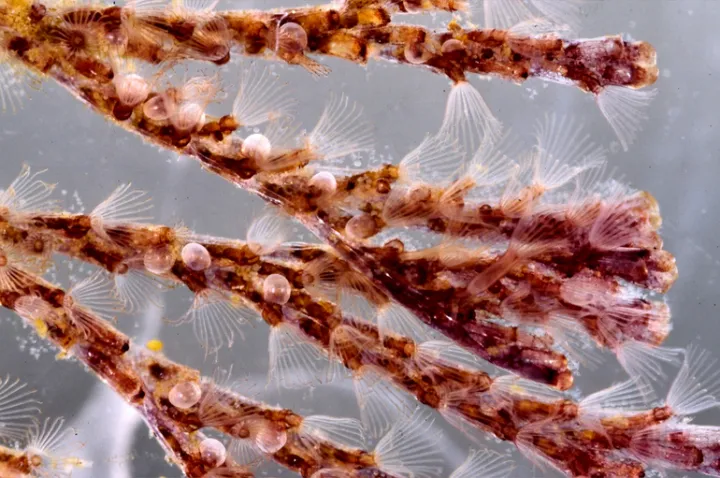Five Questions for Shirley Pomponi, Medical Sponge Hunter

 Most scuba divers scour coral reefs looking for colorful fish, natural beauty, and maybe even the perfect underwater photo. Shirley Pomponi, a biologist at Florida Atlantic University's Harbor Branch Oceanographic Institute, however, seeks new medicines by collecting sponges.
Most scuba divers scour coral reefs looking for colorful fish, natural beauty, and maybe even the perfect underwater photo. Shirley Pomponi, a biologist at Florida Atlantic University's Harbor Branch Oceanographic Institute, however, seeks new medicines by collecting sponges.
More than 30,000 new chemicals have been discovered in the last 40 years from microbes, algae, sponges, bryozoans, and other species. The organisms evolved these chemicals naturally and use them to defend against predators, communicate with their neighbors, or prevent algae and other encrusting species from growing on top of them.
Dr. Pomponi has spent nearly 30 years collecting sponges and working with chemists to find out if their chemicals could be the next cancer drug or antibiotic. On October 17, 2012, she spoke at the Smithsonian National Museum of Natural History as part of the Changing Tides series. But before she spoke, the Ocean Portal Team snagged 15 minutes of her time to ask 5 questions about marine biotechnology and how she finds medicine in the ocean.
How did you get interested in marine biotechnology?
I happened to be in the right place at the right time with the right expertise. I got hooked on marine biology in college, and then I went to grad school and I started working on sponge ecology. One day I got a call from Harbor Branch Oceanographic Institution. They had just started a drug discovery program, and they were collecting a lot of sponges and they needed somebody to help them identify sponges.
So I went down and started work in the drug discovery program at Harbor Branch and that was in 1984. I developed their whole sample acquisition program and then continued my own research in sponge cell biology and it just went on and on from there.
When you’re looking for medicinal sponges, how do you spot one in the wild?
We were looking for different things, not trying to collect the same sponge over and over again. Because we had access to manned submersibles—the Johnson-Sea-Link subs—we could go 3,000 feet deep. So we focused on areas that were steep drop-offs, rocky areas, and had unusual sponges growing there.
We’ve never been able to correlate growth size or shape or color or maturity of the sponge with any kind of bioactivity. We just make sure we’re getting a good, representative sample of the biodiversity by sampling a small piece of each one of them and then testing them.
Once you bring them back to the lab, how do you test them?
When we bring them back to the lab, what we do is make a sponge smoothie—well, more like a sponge mojito. We take [the sponge] and we grind it up in alcohol. Then we test that extract, that sponge mojito, to see if it will kill bacteria or cancer cells.
We pick the ones that show some kind of activity: for example, it killed cancer cells or it caused a specific protein that’s involved in rapid cell division to turn off. We want to find out what chemical in that mixture is responsible for the activity. Then we go back and we try to determine the mechanism of action: how does the chemical kill the cancer cell?
How many human beneficial drugs have you found so far?
We’ve discovered lots of chemicals with activity, hundreds. And worldwide in the marine natural products drug discovery community, there have probably been 20 or 30 thousand novel chemicals from marine organisms in general—probably about 8,000 from sponges alone—that are novel chemicals with some unique properties that could have pharmaceutical importance.
But the limitation is getting that from the ocean bottom to the drug store. It takes a long time to develop it. You have to go through the FDA for clinical trials and approval. It can take 15 years or more from the time you discover a drug lead till the time it’s available for human use.
Are there any that are in development now?
Yes, there are lots that are in development right now. There are some that have been available for a long time! One of the very first drugs discovered in a sponge—and it was discovered from a shallow water sponge that grows in Florida—was developed into the active component in herpes medications called Ara-A (vidarabine). However, the use of Ara-A has been discontinued because the availability of newer and better antiviral drugs on the market.
There is also a drug that was derived from a sea squirt (a little tunicate) called Yondelis (trabectedin), and it’s available in Europe for treatment of cancer. (The FDA hasn’t approved it yet here.) And there’s also a drug from cone snails that kill fish called Prialt (ziconotide) and it’s used as an analgesic. It’s more potent than morphine and it’s used to treat patients who have chronic pain from other diseases like from AIDS or from cancer.
Photo of Dr. Pomponi courtesy of Harbor Branch Oceanographic Institute, Florida Atlantic University
More from this series:


